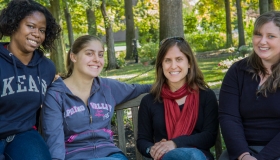
Photo Credit: Kean XChange
By: Annalise Knudson
Running from my last class and across the street to Liberty Hall Campus, I made it to the Superstorm Sandy commemoration on Tuesday, Oct. 29, out of breath with my camera ready and paper to write my notes.
I sat down in a chair near the front and watched as many other students filed into the room. Food and refreshments were offered to the students and professors who came to listen to the speeches.
The projector was set up in the middle of the room, with the words, “Superstorm Sandy One Year Later,” typed simply on a PowerPoint presentation. I looked at the three girls eager to present sitting at the table in the front of the room with the PowerPoint next to them.
Christopher Bellitto, chair of the history department at Kean University, was the first to speak. He talked about the project and the students who participated in it, and welcomed those who had come. Abigail Perkiss, a history professor at Kean, told the audience about the oral history project that her students worked on for the past 10 months.
Perkiss had an idea in her mind of a new class that would be available for students during the spring 2014 semester. Although many students had already registered for their spring semesters, Perkiss had six students who were interested in her class, Public History: Advanced Oral History Methods.
She presented the three students, Trudi Lawrence, Brittany LeStrange and Mary Piasecki, who continued their studies over the summer. Each student had a speech they would be presenting to the audience on their journey through the class and the experiences they gained from it.
The students were able to speak at the Oral History of the Mid-Atlantic Region conference, as well as at the Oral History Association meeting, a fall conference in Oklahoma City. For their internships, the students interviewed those affected by Hurricane Sandy for their exhibit.
Piasecki was the first to speak, about the program created for the Sandy relief effort. The project was called “Staring Out to Sea: The Story of Superstorm Sandy in Three Bayshore Communities.” The communities were Keansburg, Union Beach and Fort Monmouth.
Lawrence was the next student to speak about her interviews in depth. Lawrence told stories she heard about families trapped in their houses, including a woman stuck in her attic only big enough to lay down in, and couples who thought they would die from the storm and its damage.
“On TV, it’s one thing, but really being there is another, “ Lawrence said. “What if that was me?”
Perkiss then introduced a poem to be spoken by Linda Gonzalez, a woman affected by Superstorm Sandy, about her experiences as it happened and after. Around the room everyone had their heads down, sitting in silence, somber about the shakiness in her voice as she explained what happened. Chills arose on my skin as Gonzalez finished her poem with, “But we all pull together, because we are New Jersey Strong.”
LeStrange, the last student speaker, talked about the Federal Emergency Management Agency’s role in the effort to help those affected by Superstorm Sandy in New Jersey communities. Having been affected by Sandy, LeStrange was one of many volunteers who helped clean up her own house, her neighbors’ houses and communities around her.
Not only did people’s homes get completely destroyed, they had to deal with looters stealing from their homes, hoping to find valuables left behind or under wreckage from the storm. Many families had to resort to loans or diving into savings accounts, just to be able to fix and refurbish their house. LeStrange believes FEMA did not give nearly enough money to help those who needed it.
“Not one story is the same, but what comes down to it, is the devastation of the storm,” LeStrange said.
LeStrange has her own firsthand account of what happened to her house during the storm, of grabbing boxes, or anything they could carry or save, as the water rushed into her house. She described her experiences in a calm voice, and told her story of how she was just able to get back into her house a few months ago.
The six students who participated in the project all felt that their experience was one that was life changing. They felt as though this was their contribution to the Sandy relief effort.
“We have accomplished a great deal in a short span of time, and we look forward to our future,” Piasecki said. “We still have a great deal of work ahead of us, but we are excited and optimistic about the future of our project. With Dr. Perkiss as our advisor, she began our project on the right foot.
Combined with a positive attitude and hard working classmates, I know that we will continue to succeed creating history.”
